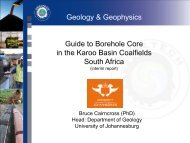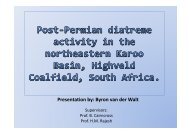coaltech upper olifants river catchment wetland inventory ...
coaltech upper olifants river catchment wetland inventory ...
coaltech upper olifants river catchment wetland inventory ...
You also want an ePaper? Increase the reach of your titles
YUMPU automatically turns print PDFs into web optimized ePapers that Google loves.
The most important fishing activity in the UORC is recreational fishing, attracting tourists<br />
from many regions, especially fly fishermen. A large number of fishing clubs occur within the<br />
UORC and every town in the <strong>catchment</strong> contains a shop selling fishing gear. Angling,<br />
therefore contributes towards the economy of the area. A value can be attached to the<br />
fishing activities associated with <strong>wetland</strong>s by estimating the total expenditure of anglers on<br />
fishing gear, licences and other costs related to fishing, such as travel costs and<br />
accommodation (Palmer et al 2002). An estimate of this total is given in Palmer et al (2002)<br />
as R16,5 million per year in the smaller UORC. It was determined that 70% of fishing takes<br />
place in dams, 20% in <strong>river</strong>s and 10% in pans (Palmer et al 2002).<br />
3.5.5.2 Birding<br />
The importance of <strong>wetland</strong>s for waterfowl habitat was identified and the conservation of<br />
<strong>wetland</strong>s forms part of the Ramsar Convention (Convention on Wetlands of International<br />
Importance especially as Waterfowl Habitat). Various Red Data bird species and bird species<br />
of concern, including the Blue Crane, Wattled Crane, Flamingoes (Greater and Lesser) and<br />
Grass Owl, are also dependant on <strong>wetland</strong>s for breeding and/or feeding activities (Cowan<br />
1995, South Africa Tourism 2006).<br />
Birding in the UORC takes place at various locations where different habitat types occur.<br />
According to Palmer et al (2002) 40% of birding takes place at dry land sites, 20% at <strong>river</strong>s,<br />
20% at dams, 15% at pans and 5% at other <strong>wetland</strong>s. Birders spend approximately R1 855<br />
440 per year on birding in the area, including birding equipment and the expenditure of a<br />
birding trip (Palmer et al 2002). This total has probably increased significantly since the study<br />
was conducted.<br />
The south-western portion of the UORC, between Bethal, Hendrina, Ermelo and Caroline is<br />
located within an Important Bird Area (IBA) (Barnes 1998). Threatened bird species<br />
occurring in this IBA includes the Bald Ibis, Lesser Kestrel, Wattled Crane, Blue Crane,<br />
Botha’s Lark, Martial Eagle, Crowned Crane, Stanley’s Bustard, Whitebellied Korhaan and<br />
Grass Owl (Barnes 1998). The primary grasslands and the <strong>wetland</strong> areas are important bird<br />
habitat areas in the IBA (Barnes 1998). No other IBAs are located on the site.<br />
Wetland Database for UORC - 41 -




